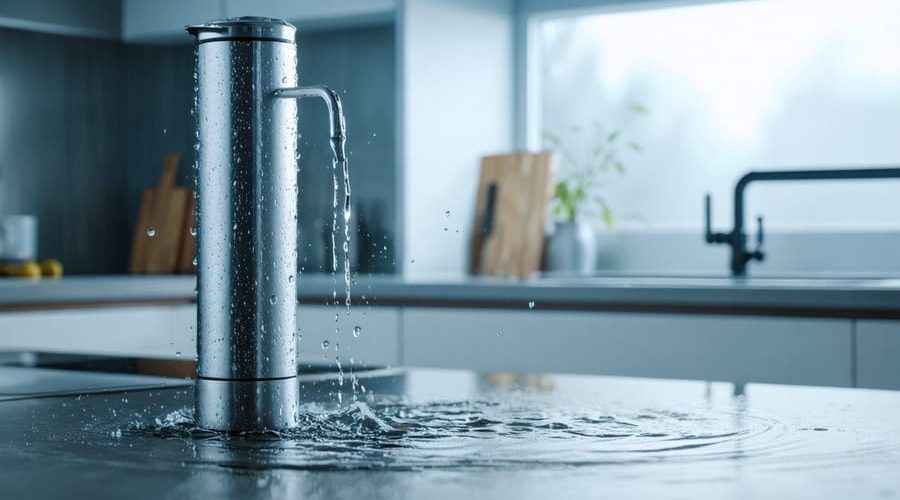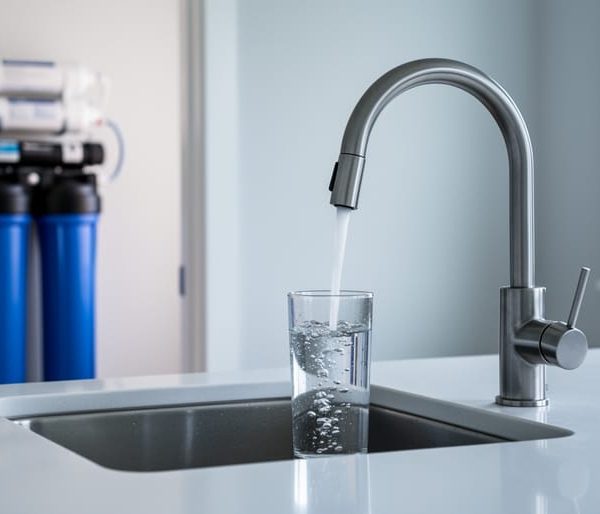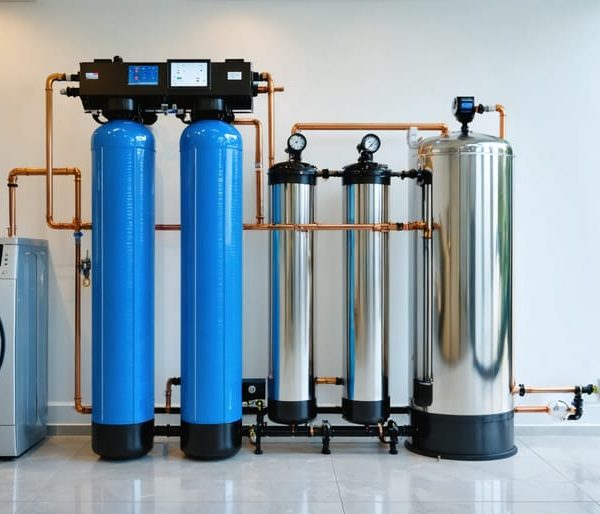Heavy metals lurking in drinking water pose a silent but serious threat to human health, with contaminants like lead, mercury, and arsenic linked to severe neurological and developmental issues. Modern water filtration technology offers a powerful defense against these invisible dangers, removing up to 99% of toxic metals through advanced processes like reverse osmosis and activated carbon filtration. Recent EPA studies reveal that over 60% of American households may be exposed to unsafe levels of heavy metals through their tap water, making effective filtration not just a luxury, but a critical health investment.
The science behind heavy metal removal in water filters combines multiple filtration stages, each targeting specific contaminants at the molecular level. While standard carbon filters can trap some metals, specialized media like KDF (Kinetic Degradation Fluxion) and ion exchange resins provide superior protection against the full spectrum of metallic threats. Understanding these filtration mechanisms empowers homeowners to make informed decisions about protecting their families from heavy metal exposure through contaminated drinking water.
This comprehensive guide examines the latest innovations in heavy metal filtration technology, real-world performance data, and essential criteria for selecting the most effective solution for your home’s specific water quality challenges.
The Science Behind Heavy Metal Filtration
Common Heavy Metals in Drinking Water
Several harmful heavy metals can be present in drinking water, posing potential health risks to households. Lead, one of the most notorious contaminants, typically enters water through aging infrastructure and old plumbing fixtures. Mercury contamination often results from industrial pollution and natural deposits, while arsenic can occur naturally in groundwater or through agricultural runoff.
Copper, while essential in small amounts, becomes problematic at higher concentrations, usually leaching from copper pipes in homes with corrosive water. Chromium, particularly in its hexavalent form, may appear in water supplies near industrial areas. Iron and manganese contamination is common in well water and can cause staining and metallic taste issues, though they’re generally less toxic than other heavy metals.
Cadmium and selenium, while less common, can enter water supplies through industrial processes or natural deposits. These metals may not be immediately noticeable in water, as many are colorless and odorless, making regular testing and proper filtration essential for maintaining safe drinking water.
Filtration Technologies Explained
Modern water filtration technologies offer multiple approaches to removing heavy metals from drinking water, each utilizing distinct mechanisms for maximum effectiveness. Understanding these methods can help you choose the right solution for your home’s specific needs.
Activated carbon filtration works through adsorption, where contaminants stick to the surface of specially treated carbon materials. While primarily known for removing chlorine and organic compounds, certain types of activated carbon can also capture some heavy metals. The carbon’s vast network of microscopic pores creates an enormous surface area for trapping contaminants, making it an efficient first-line defense.
Ion exchange technology functions like a molecular swap meet, trading harmful metal ions for beneficial ones. As water passes through resin beads, heavy metals such as lead, copper, and mercury are exchanged for safer ions like sodium or potassium. This process is particularly effective for removing dissolved metals and softening water simultaneously.
Reverse osmosis filtration represents the gold standard for heavy metal removal. This sophisticated system forces water through a semi-permeable membrane with microscopic pores, blocking up to 99% of dissolved solids, including heavy metals. While this process is more energy-intensive than other methods, it provides the most comprehensive protection against metal contamination.
For optimal results, many modern filtration systems combine these technologies in a multi-stage approach. This ensures maximum removal efficiency while addressing various types of contamination. The key is selecting a system that matches your water quality needs and maintenance capabilities while delivering reliable performance over time.


Research-Backed Health Benefits
Short-Term Health Improvements
Clinical studies have shown remarkable short-term health improvements when households switch to water filtration systems that effectively remove heavy metals. Within the first few weeks of using these filters, many individuals report significant positive changes in their well-being.
Research indicates that proper filtration of heavy metals from drinking water can lead to improved digestive health within just 7-14 days. Users often notice reduced stomach discomfort and better overall gastrointestinal function. Additionally, studies have documented decreased headache frequency and intensity among participants who switched to filtered water, particularly in areas with known heavy metal contamination.
Skin health improvements are another rapid benefit, with many users reporting clearer, less irritated skin after just two weeks of using filtered water for drinking and bathing. This is particularly notable in cases where lead and copper levels in tap water were previously elevated.
Children, who are especially vulnerable to heavy metal exposure, show enhanced cognitive performance and better concentration levels within the first month of switching to filtered water. Parents and teachers have reported improved attention spans and reduced fatigue in school-age children.
Laboratory tests conducted on individuals using heavy metal filtration systems have shown decreased levels of metal biomarkers in their blood work within 30-60 days. This reduction correlates with improved kidney function markers and better overall hydration levels.
Perhaps most notably, users report enhanced taste and odor of their drinking water immediately after installation, leading to increased water consumption. This improved hydration alone contributes to better energy levels, clearer thinking, and improved physical performance within days of making the switch.
Long-Term Health Protection
Regular exposure to heavy metals through drinking water can lead to serious health complications over time, making long-term filtration crucial for disease prevention. Research has shown that consistent reduction of heavy metals in drinking water significantly decreases the risk of various chronic conditions, including kidney dysfunction, neurological disorders, and cardiovascular diseases.
Studies conducted over multiple decades demonstrate that individuals with access to properly filtered water show lower levels of heavy metal accumulation in their bodies. This reduction correlates with decreased instances of metal-related health issues, particularly in sensitive populations such as children, elderly individuals, and pregnant women.
The benefits of long-term heavy metal filtration extend beyond immediate health protection. Scientists have observed that maintaining low heavy metal exposure through effective filtration can support better cognitive function, stronger immune system response, and healthier fetal development during pregnancy. Additionally, research indicates that reducing heavy metal intake may help prevent premature aging of organs and tissues.
Recent epidemiological studies suggest that communities using advanced water filtration systems for heavy metal removal experience lower rates of certain cancers and developmental disorders. The cumulative effect of avoiding heavy metal exposure through contaminated water becomes particularly evident when examining health outcomes over 10-20 year periods.
For optimal long-term health protection, experts recommend maintaining consistent filtration practices and regularly updating filtration systems to ensure continued effectiveness. This preventive approach not only protects current health but also serves as an investment in future well-being, potentially reducing healthcare costs and improving quality of life as we age.
Real-World Effectiveness Studies
Laboratory vs. Home Results
Laboratory testing of water filters for heavy metal removal often shows impressive results under controlled conditions, with some filters achieving up to 99% removal rates. However, real-world performance can vary significantly due to factors like water pressure, temperature, and local water chemistry.
Studies conducted in homes across different regions reveal that actual filtration effectiveness typically ranges between 85-95% for most heavy metals. This variation occurs because household water conditions aren’t as consistent as laboratory settings. For instance, whole house filtration systems might show different results depending on peak usage times and seasonal changes in water quality.
Independent field studies have found that factors like filter maintenance, replacement schedule, and incoming water quality significantly impact performance. A filter that removes 99% of lead in lab tests might achieve 90% removal in actual household use if not maintained properly. Additionally, real-world testing has shown that effectiveness can decline over time, especially in areas with hard water or high sediment levels.
To bridge this gap, many manufacturers now conduct both laboratory and residential testing, providing consumers with more realistic performance expectations. They recommend regular water quality testing and timely filter replacements to maintain optimal filtration efficiency in home settings.
Maintenance Impact on Effectiveness
Regular maintenance plays a crucial role in ensuring your water filter continues to effectively remove heavy metals from your drinking water. Without proper upkeep, even the most advanced filtration systems can experience decreased performance over time, potentially allowing harmful metals to pass through.
Filter cartridge replacement is the cornerstone of proper maintenance. As filters process water, their media gradually becomes saturated with captured contaminants, including heavy metals like lead, mercury, and arsenic. Once these filtering materials reach their capacity, they can no longer trap additional metals effectively, and in some cases, may even release previously captured contaminants back into the water.
Pre-filter cleaning and regular system sanitization also impact heavy metal removal efficiency. Clogged pre-filters can reduce water pressure and flow rate, affecting the contact time between water and filtering media – a critical factor in metal removal. Additionally, mineral buildup and biological growth can create channels in the filter media, allowing water to bypass proper filtration.
To maintain optimal performance, follow manufacturer-recommended maintenance schedules, which typically include:
– Replacing filter cartridges on time
– Cleaning pre-filter screens monthly
– Monitoring system pressure
– Conducting regular water quality tests
– Sanitizing the system annually
By adhering to these maintenance practices, you can ensure your water filter continues to provide reliable protection against heavy metals, safeguarding your family’s health and maintaining water quality.

Environmental Impact Considerations
The environmental impact of heavy metal filtration extends beyond just clean drinking water. When we filter heavy metals from our water supply, we prevent these harmful substances from re-entering the ecosystem through our wastewater systems. This creates a positive ripple effect that benefits local waterways, soil quality, and wildlife.
However, it’s important to consider the full lifecycle of water filtration systems. Most filters require regular replacement, which can contribute to landfill waste if not properly disposed of or recycled. Many manufacturers now offer recycling programs for used cartridges, and some have developed biodegradable filter components to minimize environmental impact.
The production of water filters also has environmental implications. The manufacturing process requires energy and resources, including plastics and other materials that may not be environmentally friendly. Consumers can reduce this impact by choosing filters with longer lifespans and those made from sustainable materials.
An often-overlooked benefit of home water filtration is its role in reducing plastic waste from bottled water consumption. By installing an effective heavy metal filter, households can significantly decrease their reliance on single-use plastic bottles while maintaining access to clean, safe drinking water.
The removal of heavy metals through filtration also helps protect soil quality when filtered water is used for gardening or agriculture. This prevents the accumulation of toxic metals in garden soil and food crops, contributing to healthier local ecosystems.
Looking ahead, emerging green technologies in water filtration show promise for more sustainable solutions. These include bio-based filter materials, solar-powered filtration systems, and advanced recycling methods for used filter components. By choosing environmentally responsible filtration options and properly maintaining their systems, homeowners can protect both their health and the planet.
Protecting your household from heavy metals in drinking water requires a strategic and informed approach to water filtration. Throughout this article, we’ve explored the various methods and technologies available for removing dangerous heavy metals from your water supply. The evidence clearly shows that investing in a high-quality water filtration system is crucial for safeguarding your family’s health against contaminants like lead, mercury, arsenic, and cadmium.
For optimal protection, consider implementing a multi-stage filtration system that combines different technologies such as activated carbon and reverse osmosis. Regular maintenance and filter replacement are essential to ensure continued effectiveness. We recommend testing your water quality at least annually and keeping detailed records of filter changes and maintenance schedules.
When selecting a filtration system, prioritize those certified by recognized organizations and backed by independent laboratory testing. Look for filters specifically rated for the heavy metals present in your local water supply, as identified through water quality reports from your utility provider or independent testing.
Remember that while the initial investment in a comprehensive filtration system may seem significant, the long-term benefits to your health and well-being far outweigh the costs. By taking action now to remove heavy metals from your drinking water, you’re making a valuable investment in your family’s health and contributing to a more sustainable, eco-conscious lifestyle.
Finally, stay informed about your local water quality issues and emerging filtration technologies to ensure your water treatment strategy remains effective and up-to-date.



